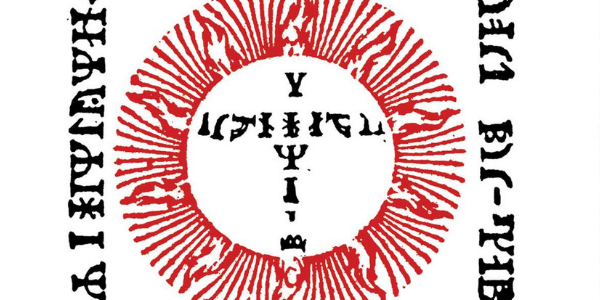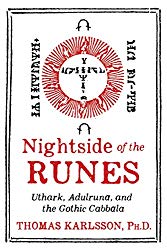
Nightside of the Runes: Uthark, Adulruna and the Gothic Cabbala, by Thomas Karlsson, Ph.D
Inner Traditions, 9781620557747, 288 pp., 2019
I had the opportunity to read and work with the information put forth by Thomas Karlsson, Ph.D in his book, Qabalah, Qliphoth and Goetic Magic (2017) and found the process of discourse selected fascinating; it offers a unique perspective on subject matter that can be complex in its understanding of any of the three components as stand alones. So, when the opportunity to read and review this work exploring the runes from the lens of the hidden rune rows my curiosity was piqued as to what new gems I might reveal in Nightside of the Runes: Uthark, Adulruna, and the Gothic Cabbala.
Just as Karlsson accomplished with his offerings of the darker nature of the Hermetic Tree, he has once again revealed in the underpinnings of runosophy (the wisdom of the runes) inclusive of the darker side of the Nordic rune system of the futhark using the works of Swedish mystic and runologist Johannes Bureus (1568-1652) and professor Sigurd Agrell (1881-1937). Both gentlemen devoted their life’s work to revealing the mysteries of an alternative understanding and use of the runes traditionally only taught to the highest initiates. Much of this hidden understanding lies in the placement of the runes and the dialogue created when a specific rune informs the dynamics of the overall meaning of the runic row.
Nightside of the Runes is divided into two parts. The first, “Uthark: Nightside of the Runes,” provides highlights of the work of Sigurd Agrell regarding runes, magick and mysticism and the Uthark’s metaphoric connections to Norse spirituality. The second part, “The Adulruna and the Gothic Cabbala,” explores the work of Johannes Bureus and his revelatory interpretations of the Adulrunes (“noble”), their connections to the Judaic mystical kabbalah and how these interpretations and usage became part of a tapestry of weavings created by the philosophies of western esotericism and Gothicism.
The introduction sets the tone for the purpose and, more importantly, the approach to runosophy has been as the rootwork of decoding the inner meaning of the futhark, when these same runes are assigned different numerological correspondences. Much like the mysteries of the Hebrew letters and ancient characters of inscription, the Uthark’s meanings in the rune rows changes and the characters take on more of the energy that is hidden, holding its power as originating in darkness. “In the Nordic Tradition the darkness is the prerequisite for the illumination,” Karlsson writes, “The secrets of existence are hidden in the underworld”1
The first chapter provides an interesting overview of Norse mythology and cosmology that provide the reader with the necessary basic understanding of the energies held in the runes and their importance as tools of spiritual development and connection to the polarities of light and dark. This introduction flows into the use of numerology as applied to the nordic runes as a well-tested case for the collaboration of science and esoteric pursuits, and the impact of vibration created through numerologic correspondence. This chapter concludes with commentary on the importance of Sacred Places in decoding the mysteries as an important reminder that power is often in plain sight and that these centres of wisdom were created and enlivened using the principles of number, geometry, vibration and the resonance of inscription and deeper understanding.
The rune row or runic alphabet is not… comparable to the Greek or Roman alphabet. The rune row begins with another set of letter – f, u, th, a, r, k – and thus the rune row is called the Futhark….The runes were not originally letters for writing but were instead magical symbols.2
Chapters 2 through 9 begin the process of orienting the reader to the basis of theory, despite, as we are told the lack of archeological evidence, to support the derivation of the Uthark and its rationale for departure from the more traditionally used Elder Futhark. To accomplish this weighty task, Karlsson gives the reader a crash course in runic lore and the corresponding cosmology and interpretations given interwoven within Norse spirituality. The supportive components for the case of the Uthark with emphasis here being on the perspective of the world’s creation occurring from chaos and darkness-the premise of the Uthark’s specific patterning.
Part 2 “The Adulruna and the Gothic Cabbala” (translation by Stephen E. Flowers) builds upon the foundation previously crafted and examines the work of Swedish mystic and runologist Johannes Bureus. The primary focus of this chapter’s inclusion in the book is based upon Bureus’ most important esoteric text, Adulruna Rediva and its role in redirecting the philosophies of Gothicism and esotericism. Here it should be noted that the term “Gothicism” is used in reference to a cultural movement in Sweden focused on the glorification of the Swedish Geats (Goths) and belief that the origins of the Goths. The Goths were a group of people whose origins have been disputed varying from having origins as a Germanic tribe or from southern Scandinavia. The Goths had their roots, as did most of the ancients in pagan philosophies. As such, they were presumably responsible for preserving Roman culture, including the esoteric wisdom and practices, although they also are credited as invaders of the Roman Empire.
Chapter 10 gives a much needed discourse of background information relating to the philosophies of the Goths, the overlays with Western Esotericism and the connection perceived by Bureus between the runic system and the Cabbalistic (Kabbalah) principles of Jewish Mysticism. This I found particularly helpful in being able to see why these disciplines would be used as comparatives. Karlsson writes,
The concept of Western Esotericism is a methodological construction that researchers developed to cover several different movements, thinkers and traditions that, despite great differences, have meaningful common denominators. Western esotericism can be viewedas the third stream of thought alongside Greek rational thought and Judeo-Christian faith, the two great intellectual traditions upon which Western culture rests3
In keeping with the flow of the first part of Nightside of the Runes, the reader is again treated to enough information covering the origins of esotericism, its related constructs and anything else that would provide an adequate foundation for understanding the focus material of the Adulrunes and kabbalistic correlates. Chapter 12 does not disappoint in presenting the Adulrunes, the place they hold in a new configuration of the rune row designed by Bureus. The concluding chapters explore the integration of kabbalistic ideologies within the runic system, the societal context of Gothicism and its continuation, albeit taking on other forms of practice, and the contributions of Bureus’ successors in bringing modern relevancy to the overall work.
Nightside of the Runes concludes with a sampling of initiatory experience as put forth by the Manheim League in the 1800s in response to the lessening of interest or inclination towards preserving the Gothic principles. The intention being one of teaching the young adepts in the ways of Gothic virtues through union of body and soul. To this end, the nine levels of initiation were goals to be undertaken and the completion would sustain the philosophies of Gothicism and fulfill the needs of western esotericism.
Although, Nightside of the Runes was written for a very specific audience, this book is definitely worth a look by anyone studying the occult. The lengthy and impressive notes and bibliography sections provide everything needed for further study or inquiry. This is not by any means a light read, but I found it to be engaging and feel it would be of particular interest to any who like to peel back, layer by layer, in deepening their understanding of the motivation and historical relevance of this or any of the esoteric disciplines. Karlsson reminds us that there are many ways of interacting with all of the magickal arts and that the organic polarities of light and dark flow through every endeavour. Having the benefit of both perspectives provides a wholeness that is only achieved when we embrace each on equal footing.








